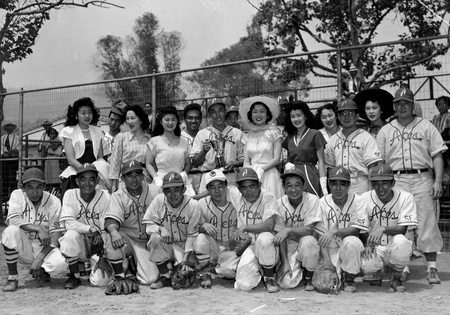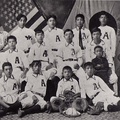Baseball players from the Stockton and Yamato teams around 1930. Rev. Sensho Sasaki Collection, Gift of the Sasaki Family, Japanese American National Museum [96.150].
Just as baseball provided a window by which Japanese American rural life in towns such as Livingston and Cortez could be observed, urban Nisei, like those in Seattle, also relied on baseball as a means to express their American patriotism. There, the Japanese American Courier, a Seattle-based weekly newspaper that began publishing in 1928, took the lead role in promoting “Americanism” to the readers, and to that end, the journal strongly supported local baseball activities when it sponsored a league named after itself. Between 1928 and 1941, the Courier League comprised up to 35 teams: although Seattle proper was home to most teams, other towns such as Auburn, Kent, Fife, Tacoma, and Eatonville also fielded teams. The Courier League organized traveling all-star squads that competed against clubs from other Japanese enclaves on the West Coast. All of these activities took aim at the Nisei, whom leaders believed had a duty to eventually become “an integral part of the [American] national life.”
James Yoshinori Sakamoto spearheaded both the paper and, eventually, the league. A Nisei born in Seattle in 1903, Sakamoto developed a reputation as an all-around athlete during his high-school years; following his graduation, he traveled eastward and was eventually hired by New York City’s Japanese-American News. He also taught boxing, and at one point he competed in a professional match at the famed Madison Square Garden. Boxing, however, took its toll on his body and led to his early blindness.
In 1927, the nearly sightless Sakamoto returned to Seattle and threw himself into civic affairs within the Japanese American community. In 1929 he founded the Japanese American Courier as a vehicle for news and opinion of special interest to Nisei and to offer them an American perspective and a forum in English, their native language. Gripped by the notion that Japanese Americans needed to exhibit their patriotism on a larger scale, that same year he visited San Francisco to discuss his aims with other like-minded leaders. The following year, Sakamoto and others in Seattle founded the Japanese American Citizen’s League (JACL), an organization destined to become among the Nisei’s most important proponent of American loyalty. Adopting many of Sakamoto’s principles, the JACL stressed and promoted Americanization. “Only if the second generation as a whole works to inculcate in all its members the true spirit of American patriotism,” Sakamoto believed, “can the group escape the unhappy fate of being a clan apart from the rest of American life.”
Baseball, a sport dubbed the “national pastime” since 1850 because of its perceived attraction to all classes and ethnicities, fit well into this philosophy, carrying with it as it did the framework of democracy and the implication of “American” values. Moreover, the national pastime already had established roots in the community by the time the JACL came into existence: there exists evidence of baseball competition between Issei and Caucasian opponents as early as 1904. The following year, when a Japanese team from Waseda University visited and played exhibitions in the Puget Sound area, enthusiasm for the sport increased and baseball exchanges between Japan and the United States continued for the next two decades, spearheaded in part by an Issei Frank Fukada. Fukada loved baseball, and his promotion of the sport in the region between 1908 and 1927 earned him the title “father of Japanese baseball in the Pacific Northwest.”
By the late 1920s, Seattle’s Taiyo and Nippon athletic clubs were among the most popular in the Japanese American community. Their members participated in a number of activities and also competed against Caucasian teams. But, although American history revealed that sport was often a means of acculturation into mainstream society, discrimination towards the Nisei drove many to satisfy their athletic appetites amongst themselves. “I made the high-school [baseball] team when I was a freshman. I played the whole season, every game, every inning,” claimed Kenji Kawaguchi. “But outside the ballgame, [whites] weren’t friendly with you. So I realized that was not the kind of situation I’d give my efforts to. So, after my freshman year, I quit. I’d rather play Sunday ball with my friends.”
A former athlete himself, James Sakamoto recognized the impact that sport had on the Japanese American community, and to that end, through his paper, he advanced this interest with the hope of strengthening ties within his enclave. Recommending that an “athletic union” be formed, he drafted a constitution for a recreation league. Christening it the Courier Athletic League, Sakamoto and his supporters not only sought to enhance the “physical attributes” of the athletes, but also to set standards of behavior, stressing that the players and coaches “be representative of a sportsmanlike and high code of ethics.” The Courier’s sports department served as the league’s office. Within the next few months, Japanese American teams throughout Seattle and many from the rural communities committed themselves to the league. Hideo Hoshide, who at one time served as the Courier’s sports editor, said, “The Japanese community felt that they would have to have their own recreational type of activity, and the Courier League was an offspring of that.” S. Frank Miyamoto concurred: “It was the Courier that conceived the idea of organizing all the independent Nisei teams in the community….” There was an intriguing combination of members, including Buddhist and Christian churches, YMCAs, and Japanese language schools. There were teams for children as well as young adults.
Sports-minded merchants, of which there were many, donated money, equipment, and uniforms for local clubs. The Japanese American Courier, in addition, was the clearinghouse for league activity; teams from outside the community, for instance, contacted the Courier offices seeking competition. Nisei teams in Portland; Washington’s Yakima Valley; and Vancouver, British Columbia, arranged games through the Courier. In addition, the league came to include basketball, football, and other sports. Finally, a division of women’s athletics emerged by the mid-thirties, and its basketball program was quite popular.
Throughout the 1930s, however, America’s national pastime always took center stage. And, like their brethren in California, baseball was the sport of choice for Nisei in the Pacific Northwest. “One can speak of rising interest in football and basketball as there has been,” wrote Hosokawa, “but it takes old Abner Doubleday’s orchard pastime to bring out the papas and mamas of the rising generation.” Seattle all-too-infrequent sunny weather added to the festive spirit that accompanied the beginning of another baseball season. “Nipponese ball fans will be out in howling droves to cheer and jeer with the vociferous enthusiasm only dyed-in-wool lovers of baseball can display,” reported the Courier in anticipation of the 1937 campaign. “And how the Nipponese love their baseball.”
Because the Issei loved baseball too, the Courier League ball games did much to bridge the generational differences between them and their offspring. “The older people were interested. In those days most people didn’t have cars, and there were not too many activities available [outside of the Japanese American community]. So they came to the games to watch their young ones play. It was community involvement,” remembered Kenji Kawaguchi.
It was the Issei, after all, who in an earlier era had planted the seeds for organized sports. Indeed, first-generation immigrants in America routinely “fostered athletic participation by the second generation, under the supervision and direction of ethnic recreation leaders, in hopes of maintaining an ethnic identity for the American-born and reared,” writes historian Steve Reiss. Moreover, Issei parents could relate to baseball, because many fathers had once played, and some later participated as coaches. “Baseball served to bring together the two generations and lessen the generation gap between the immigrant fathers and their American-born sons,” points out Gail Nomura in her study of the Wapato Nippons, an eastern Washington ball club. “In baseball the immigrant fathers could come together with their sons in a shared passion.” And baseball, to the relief of many Issei, did not threaten the traditional Japanese values of courage, honor, and respect for cultural heritage.
In 1931, the Courier League organized its first Northwest Tournament. This, the crowning jewel of the season, was strategically held on the Fourth of July weekend. Nisei baseball powerhouses from as far away as Idaho gathered in the Seattle area to participate in what came to be an exceedingly popular gala. “Thousands of Japanese Americans from Washington, Oregon, and Idaho came by car, train, and boat to the tournament,” writes Nomura. “It was the biggest social gathering of the year for the Japanese American community of the Pacific Northwest.” The baseball season generally lasted from April to late July, and the tournament provided great promotion for both the league, and of course, the newspaper. By the mid-1930s the tournament routinely drew more than 200 players.
Although Seattle’s Nisei baseball enjoyed wide-spread support, it did not always please its community constituents, because games set for Sunday mornings sometimes conflicted with church services. In 1941, for instance, one disgruntled Tacoma minister lobbied for a schedule change. Morning games created a “serious drain on Church attendance,” he wrote to Sakamoto. “On numerous occasions [players] have had to walk out in the middle of a meeting to attend a baseball game.” Moreover, he argued, it would make a poor impression on visiting Caucasian ministers “to tell our speaker ‘Sorry about the boys not attending, they had to play a baseball game.’ It would do the Nisei a great deal of harm, especially if this type of news leaked out into the American community.” Morning contests, much to his chagrin, continued. Indeed, one can imagine the preacher’s reaction upon witnessing his congregation melt right before his eyes each Sunday during baseball season.
The Nisei played America’s national pastime with zeal. A sport adopted from their Japanese-born parents and rooted in American democratic values, baseball was well suited to pacify proponents of heritage and nationality. Moreover, traveling teams fortified the community network system during the 1930s and into the internment period. Philosophical or even patriotic purposes, however, were not at the forefront of their desire to play; few, if any of the players, competed solely for the purpose of acculturation or to exhibit the legendary samurai spirit. Baseball was played from the heart. And from this pulse, a community spirit was fueled, a community spirit which proved to be a powerful impetus for cultural cohesion, completion, patriotism, and when times were toughest, morale.
*This article was originally published in More Than a Game: Sport in the Japanese American Community (2000).
© 2000 Japanese American National Museum




